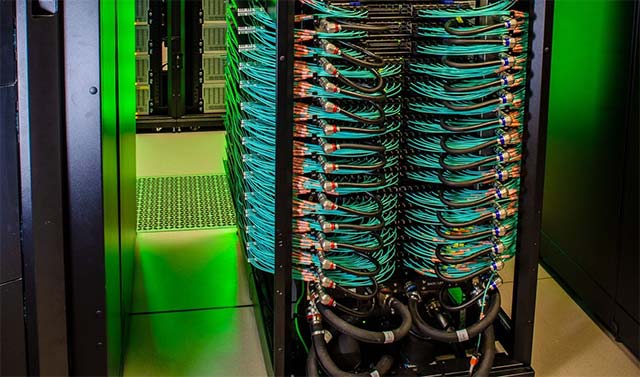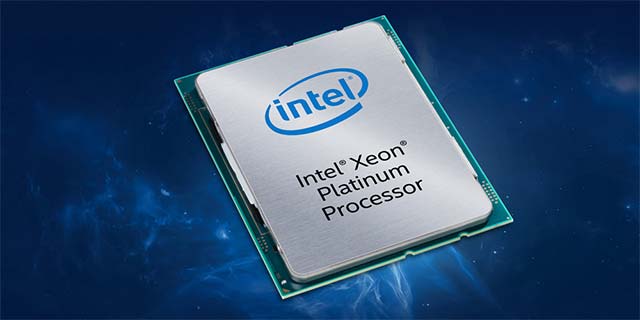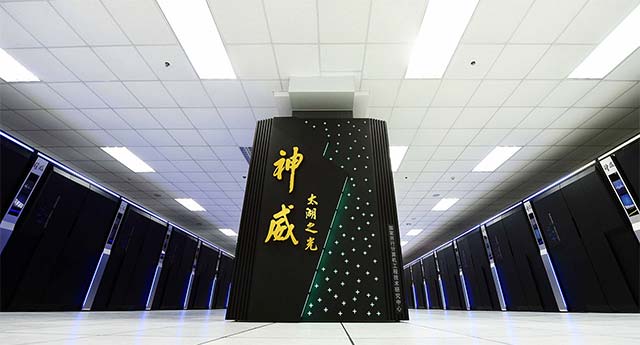Intel unveiled Frontera, the fastest academic supercomputer in the world
If you are interested in supercomputing, you probably still remember in August last year, Dell EMC and Intel announced a plan to attract the attention of many experts and lovers. technology all over the world, that's how these two 'giants' in the computer manufacturing industry will work together to design and develop the world's most powerful academic supercomputer called Frontera.
The project soon received huge funding of up to $ 60 million from the US National Science Foundation, and was chosen to be a great name for Stampede2 - a supercomputer that old and served for years at the Austin Advanced Computing Center (TACC).
- It only took Nvidia 3 weeks to create one of the world's most powerful AI supercomputers
 Advanced Austin Texas Advanced Computing Center, loosened "residence" of Frontera supercomputer
Advanced Austin Texas Advanced Computing Center, loosened "residence" of Frontera supercomputer
And now, after more than a year of hard and serious work, Dell EMC and Intel have officially given mankind the unique "technology super".
Intel experts claim that Frontera supercomputer can achieve the highest performance at 38.7 million billion floating point operations per second (FLOPS), equivalent to 38.7 petaflops, making it into one of the fastest computers in the world specifically designed for heavy workload-related tasks in academic fields such as modeling and simulation, big data and machine learning. For convenience, you can refer to the 18 petaflops power of Stampede2 supercomputer. In theory, Frontera is twice as strong as Stampede2. However, Frontera is still much inferior to today's fastest supercomputer, the monster called Summit of IBM. The power of Summit can reach more than 200 petaflops, which is a million times faster than most commercial computer systems commonly used in the world today, and 5 times more than Frontera. .
- AMD and Cray will build the world's fastest supercomputer for the US government
 Stampede2 supercomputer in Austin Texas Advanced Computing Center
Stampede2 supercomputer in Austin Texas Advanced Computing Center
That's theoretically maximum performance, and with actual measurements made earlier this year, Frontera has earned fifth place in the list of the world's Top 500 most powerful supercomputers with 23.5 petaflop, as measured by LINPACK benchmark tool.
Under the plan, the Frontera system will provide academic researchers with the ability to calculate and handle artificial intelligence-related jobs with extremely high levels of complexity, even never existing before. 'With the integration of many Intel-exclusive technologies, this supercomputer opens up a wealth of new possibilities in the field of scientific and technical research in general, thereby fostering deeper understanding. for complex, scholarly issues related to space research, cures, energy needs, and artificial intelligence, 'says Trish Damkroger, Intel vice president and general manager of the team. Intel computing official Trish Damkroger said.
- Supercomputers can fully detect cyber threats
Hundreds of 2nd generation Xeon processors that can be expanded to 28 cores (Cascade Lake) housed in Dell EMC PowerEdge servers will be responsible for handling Frontera's heavy computing tasks, besides Nvidia nodes. ensure single-precision calculation. Frontera's processor architecture is built on Intel's advanced Advanced Vector Extensions 512 (AVX-512) model. Basically, the AVX-512 is a set of instructions that allows doubling the number of FLOPS per clock speed compared to the previous generation.
It is also important to mention that one extremely important part of a supercomputer is the cooling system. Frontera uses a liquid cooling mechanism for most of its nodes. In particular, Dell EMC is responsible for water and cooling oil, combined with CoolIT and Green Revolution Cool systems. This supercomputer uses Mellanox HDR and HDR-100 connections to transfer data at up to 200Gbps on each link between the switches, which is responsible for connecting 8.008 nodes across the system. Each node is expected to consume about 65 kilowatts of electricity, about one third of which is used by TACC from wind and solar power to save costs.
- This is the most beautiful data center in the world, and it is located in the church of God
 Frontera will provide academic researchers with the ability to calculate and handle artificial intelligence-related jobs with extremely high complexity.
Frontera will provide academic researchers with the ability to calculate and handle artificial intelligence-related jobs with extremely high complexity.
In terms of storage, Frontera owns 4 different environments designed and built by DataDirect Networks, which will have a total of more than 50 petabytes paired with 3 petabytes of NAND flash (equivalent to about 480GB of SSD storage. on each node). Besides, this supercomputer also possesses extremely fast connectivity, with a speed of up to 1.5 terabytes per second.
Finally, Frontera is also very effective at Intel Optane DC, the 'non-volatile' memory technology developed by Intel and Micron Technology, which has PIN and DDR4 compatibility, and incorporates a large cache memory. with a smaller DRAM group (192GB per node), thereby improving performance improvement. Not stopping there, Intel Optane DC on Frontera is also combined with the latest generation Xeon Scalable Processors, delivering up to 287,000 operations per second, compared to 3,116 operations per second of Conventional DRAM systems. With such equipment, Frontera's reboot time only takes 17 seconds.
- Introduced in the 90s, super 30-year-old supercomputers are still running 'ferry ferry' and play important roles in many countries.
 Xeon Scalable Processor used on Frontera supercomputer
Xeon Scalable Processor used on Frontera supercomputer
Frontera has been used for testing by some of the world's leading scientists, such as Manuela Campanelli, a famous astrophysicist professor at the Rochester Institute of Technology, and director of the Center for Computational Research. relatively computational and gravitational, in order to process a simulation that can explain the origin of the energy explosion emitted during the annexation of a neutron star in the universe - extremely complex work. Professor George Biros of UT Austin Frontera has also successfully used the power of this supercomputer to build biological physics models that simulate the ability of brain tumors to develop. More effective diagnosis and treatment of gliomas, a dangerous brain tumor. And finally, the case of Olexandr Isayev, an associate professor of computer science at the University of North Carolina. The expert used the Frontera supercomputer to train an AI model that can describe the potential force and energy fields of a molecule based on their 3D structure.
Prior to being officially introduced, Frontera was involved in more than 10 advanced computer systems currently being deployed at TACC, including Lonestar and Maverick, and this supercomputer is expected to serve for five consecutive years. , before moving on to the next stage involving accelerator systems for application purposes, including quantum simulators and tenor core systems.
- The most powerful supercomputer currently, has 1 million processing cores, equal to 1% of the brain power
Basic specifications of Frontera supercomputer
Basic calculation system
The configuration of each node in Frontera is described as follows (Frontera owns 8.008 available nodes):
- Processor: Intel Xeon Platinum 8280 ("Cascade Lake"); Number of cores: 28 per socket, 56 per node; Pulse Rate: 2.7Ghz ("Base Frequency")
- Maximum node performance: 4.8TF, double precision
- RAM: DDR-4, 192GB / node
- Local drive: 480GB SSD / node
- Network: Mellanox InfiniBand, HDR-100
Subsystems
Liquid submerged system:
- Processor: 360 NVIDIA Quadro RTX 5000 GPU
- Ram: 128GB / node
- Cooling: GRC ICEraQ ™ system
- Network: Mellanox InfiniBand, HDR-100
- Maximum performance: 4PF single precision
Longhorn:
- Processor: IBM POWER9-hosted system with 448 NVIDIA V100 GPUs
- Ram: 256GB / node
- Storage: 5 petabyte filesystem
- Network: Infiniband EDR
- Maximum performance: 3.5PF double precision; 7.0PF single precision
The arrival of Frontera has helped the United States continue to maintain and consolidate its number one position in the field of supercomputers, in the face of China. Currently, Summit and Sierra are two supercomputers that help the US maintain its leading position for many months, and the presence of Frontera will help the country have one more name to appear in the list of 10 powerful supercomputers. best of the world.
China's second position is something that has been well-informed before the country has been unable to introduce a new machine for several months. According to information from the South China Morning Post, China is planning to invest from billions of dollars in the coming years to regain the No. 1 position. Previously, the United States has usurped China from 2018, officially ending The achievement of dominating for 5 consecutive years of the world's most populous country in the field of supercomputers.
- Which country owns the most powerful supercomputers today?
 China is planning to invest billions of dollars in the coming years to regain its No. 1 position in the world of supercomputers.
China is planning to invest billions of dollars in the coming years to regain its No. 1 position in the world of supercomputers.
The production capacity as well as the number of supercomputers owned is one of the most important technological prowess for any country in the modern world today. In fact, the power of supercomputers will be utilized primarily in scientific research, especially in areas such as health and astronomy. The investment cost for a supercomputer system from research, development to hardware and assembly is huge. But the benefits are quite commensurate.
It can be said that supercomputers are indispensable devices for the common development of all humanity.
You should read it
- Summit, the world's most powerful supercomputer used to find a way to treat Covid-19
- China surpassed the US in the supercomputer race
- The most powerful supercomputer today, has 1 million processing cores, equal to 1% of human brain power
- AMD and Cray will build the world's fastest supercomputer for the US government
- Which country owns the most powerful supercomputers today?
- The DGX-1 supercomputer uses Nvidia's Volta GPU to bring 400 servers into one box
 What is IFA?
What is IFA? Ho Chi Minh City has deployed the application 'Lookup for medical examination and treatment' on smartphones
Ho Chi Minh City has deployed the application 'Lookup for medical examination and treatment' on smartphones Pokémon Masters 'pocketed' 10 million downloads in just 4 days
Pokémon Masters 'pocketed' 10 million downloads in just 4 days '996' - The implicit law turns Alibaba and Tencent into hundreds of billions of dollars
'996' - The implicit law turns Alibaba and Tencent into hundreds of billions of dollars Despite Microsoft's efforts, Windows 7 is still used in nearly 50% of businesses surveyed
Despite Microsoft's efforts, Windows 7 is still used in nearly 50% of businesses surveyed Microsoft revealed new tablet interface information for Windows 10, specifically for 2-in-1 devices
Microsoft revealed new tablet interface information for Windows 10, specifically for 2-in-1 devices